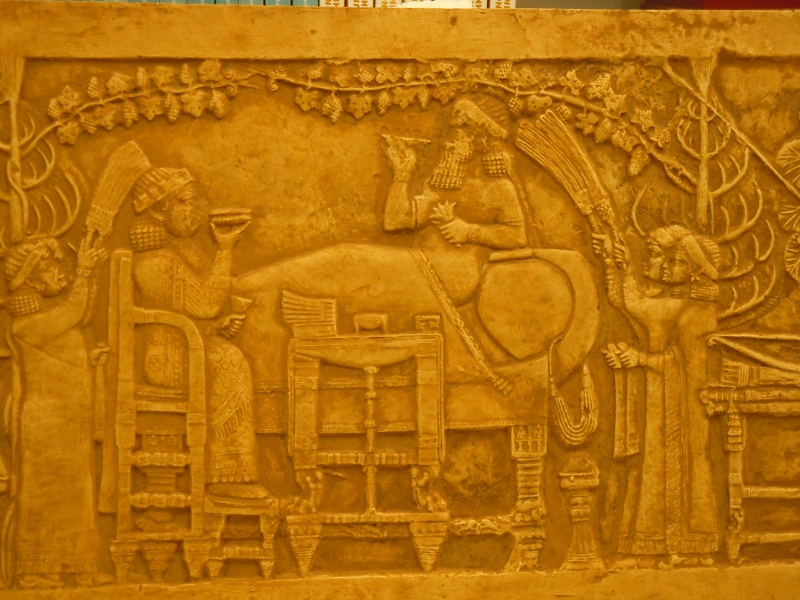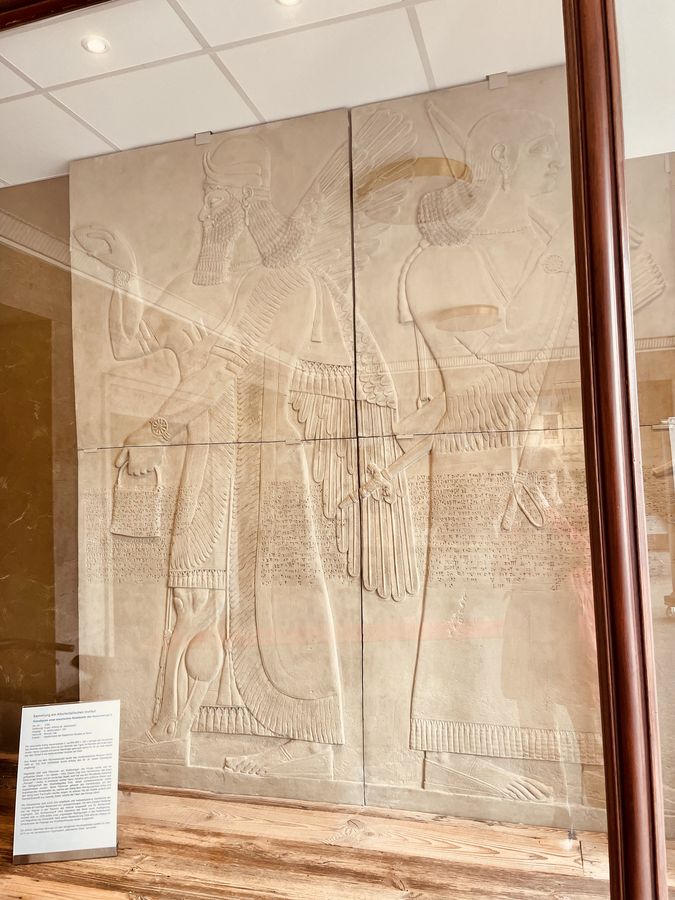Since the collection came into being, there have been numerous donations and purchases, but also losses during the Second World War. Today, the Institute of Ancient Near Eastern Studies houses a study collection of 58 cuneiform tablets and a cylinder seal. In addition, the institute has 22 plaster casts, mostly of Neo-Assyrian reliefs, and a copy of the Code of Hammurapi.
Tablet Collection
The Institute of Ancient Near Eastern Studies houses a study collection of 58 cuneiform tablets and a cylinder seal.
The history of the collection begins after Heinrich Zimmern founded the Semitic Institute at the University of Leipzig in 1900. Purchases and donations resulted in a collection of over 300 clay tablets and cylinder seals. When the former institute at Schillerstrasse 7 was destroyed in a bomb attack on the night of December 3rd, 1943, a large part of the collection was lost, including all cylinder seals and the collection documentation. Only a small part survived.
Only four cuneiform tablets from the collection were published by Heinrich Zimmern, Herbert Petschow and Manfred Müller during the 20th century. The existing collection has now been published as the first volume in the series Leipziger Altorientalistische Studien with the collaboration of Hans Neumann, Carsten Tardi, Walther Sallaberger, Takayoshi Oshima, Vincent Walter, Suzanne Herbordt and Michael P. Streck (2011). A selection of the tablets is on display in the Georg Steindorff Egyptian Museum.
An inscribed brick belonging to the Babylonian king Kurigalzu II (1345–1324 BCE) from Dur-Kurigalzu (approximately 30 km west of Baghdad) was donated to the Institute from a private collection. This brick was imported to Germany from Iraq in the 1960s.
The Tablet Collection at the Institute of Ancient Near Eastern Studies
Photographs of selected objects in the collection:
- LAOS 1, No. 2 - Ur-III economic document
- LAOS 1, Nr. 39 - Old Babylonian economic document
- LAOS 1, Nr. 41 - Old Babylonian legal document
- LAOS 1, Nr. 44 - Old Babylonian legal document
- LAOS 1, Nr. 46 - Old Babylonian letter
- LAOS 1, Nr. 49 - Old Babylonian letter
- LAOS 1, Nr. 51 - Old Babylonian omen text
- LAOS 1, Nr. 52 - Nuzi contract
- LAOS 1, Nr. 54 - Neo Babylonian legal document
- LAOS 1, Nr. 56 - Neo Babylonian legal document
- LAOS 1, Nr. 57 - Neo Babylonian legal document
- LAOS 1, Nr. 58 - Neo Babylonian fragment
- Achaemenid stamp seal
- Inscribed brick of the Babylonian King Kurigalzu II
Collection of Plaster Casts
The Institute houses 22 excellent plaster casts of:
- Neo Assyrian (9th and 7th century BCE) and late Hittite (10th century BCE) reliefs
- a statue of Gudea, ruler of Lagash (22nd century BCE)
- the famous Code of Hammurapi, one of the oldest law collections in the wordl (18th century BCE)
The originals are kept at the Vorderasiatische Museum in Berlin, the British Museum in London, and the Louvre in Paris.
The collection was created at the beginning of the 20th century, shortly after the founding of the then Semitic Institute in 1900, in order to give students direct access to the monuments of the Ancient Near East. Until the Second World War, all the reliefs and statues were exhibited in the institute's rooms where they served their intended purpose. They survived the destruction of the institute in 1943 but could not be properly presented again during the decades of the GDR era. They were kept in the university's cellars and storerooms, sometimes under poor conditions (humidity). Only the two sculptures could be exhibited in the Ancient Near Eastern Institute, which was newly founded in 1993 and was housed in various locations until 2009, when the institute moved to its current location at Goethestraße 2. Several reliefs were restored with funding from the Vereinigung von Förderern und Freunden der Universität Leipzig e.V. and are now displayed in a shop window in the passage under the Krochhochhaus and in the rooms of the institute.

Carved in Stone - Cast in Plaster
Historical plaster casts at the Institute of Ancient Near Eastern Studies, Leipzig University
An exhibition at the Egyptian Museum „Georg Steindorff“ from 25.1. until 27.5.2018.
For the first time, the exhibition is showing the more than 100-year-old plaster casts of important monuments from the cultures of the Ancient Near East to the public. In addition to their didactic value, the copies demonstrate above all the early and intense interest in foreign worlds in Leipzig.
The institute now houses a cast of the world-famous codex of the Babylonian king Hammurapi, a 2.25 meter high stele with one of the oldest collection of laws in the world from the 18th century BCE. There is also a copy of the famous Gudea statue (around 22nd century BC). Both originals are in the Louvre; cast marks prove that the copies were made in Paris around 1900. Other casts come from reliefs from the legendary city of Nineveh, mentioned in the Bible, by the Assyrian king Assurbanipal (7th century BCE). They were acquired around 1910 from the internationally leading plaster foundry D. Brucciani & Co London, as the signatures reveal.
In the 2017/18 winter semester, a course was held at the Institute of Ancient Near Eastern Studies in which the students, together with the Near Eastern archaeologist and exhibition organizer Prof. Dr. Ellen Rehm prepared the studio exhibition on the plasters.
The Staatlichen Kunstsammlungen of the city of Dresden loaned a cast of the Gudea statue from their old plaster shop. This created a unique presentation, because mold and cast had never been seen together before. The University of Jena was also participating with casts from its world-famous Hilprecht collection.
Prof. Dr. Michael Streck, head of the Institute of Ancient Near Eastern Studies, is very pleased to be able to present the casts with their eventful and interesting history to the public. They are closely linked to the subject of Ancient Near Eastern Studies, which first established itself as an independent scientific discipline in Leipzig. (press release)

